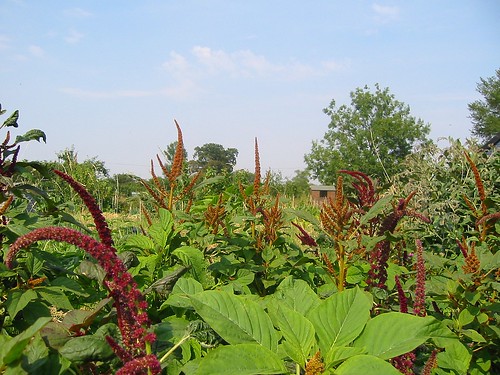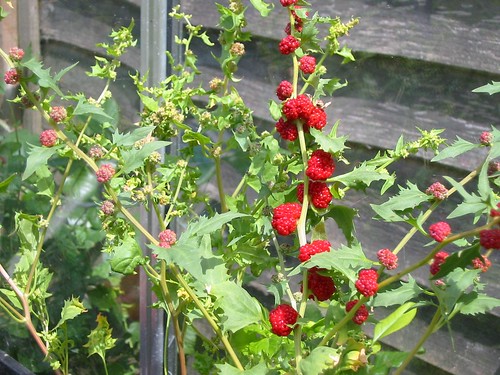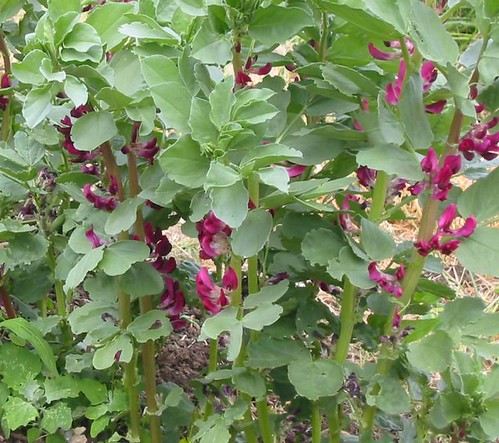This is a fascinating subject for those of a horticultural bent who also have interests in botany and history, and very few of us grow vegetables at home as a purely utilitarian activity however much we claim to be aiming for self sufficiency and locavorism. We all have our favourite plants and particular interests in the varieties that have associations in our lives or that we simply find best to eat. Or is that just me?

Certainly I started growing odd plants from seed as soon as I had my first home with enough space - the almost squat we moved into when I was 18. The garden was full of Japanese knotweed - if only I'd known then that it can be eaten - but this noxious weedy intruder was sufficiently alien and unusual to me to study it and that piqued my interest in odd plants. I've never stopped looking for the next original experience in the garden since.

So in the last very many years I've always had something unusual growing in the garden. To begin with it was mostly just odd coloured vegetables, blue potatoes, yellow carrots, green tomatoes but as more exotic produce started appearing in the supermarkets I branched out into tamarillos, oca, avocado and mango plants (sadly never fruitful). I grew unusual herbs, ornamental fruiting bushes like japanese quince and fuchsias for berries, anything really that was both unusual as a food but produced something delicious to eat. And if you are a regular reader of this blog you will know the habit persists, most years I try something new and there is even a continuing theme with Andean vegetables which I plant in a Peru corner each year.

And although it is fun it is a subject with wider implications in horticulture and society. Food security is becoming more and more important throughout the world and we all have a responsibility towards nurturing potentially planet saving crops. I asked Emma a few questions on some of the issues surrounding this:
The home gardener is under siege these days from a two pronged attack of multinationals trying to ring fence all crops by patent to increase their profits and the governments attempting to improve standards by imposing bureaucratic laws to the detriment of smaller producers. Do you think the boom in interest represents a citizen's movement in asserting our civil rights to grow what we want or is it just a fashion fad?
 I think it’s both. Unusual edible
plants have, for the last few decades, been mainly of interest to
fringe groups – environmentalists, or permaculturalists, people who
don’t like the way the mainstream world has been going. There are
constant threads, of the desire to maintain our heritage crop
varieties, or to grow organically, that have waxed and waned but
never gone away. Environmental messages are becoming more mainstream,
and getting more attention, but there’s also increasing interest
from commercial companies who see unusual edibles as a new market,
and who are capitalising on people’s love of both gardening and
novelty. If the new plants aren’t as successful as hoped, they will
go the same way as the heritage varieties, and be sent firmly back to
the fringe.
I think it’s both. Unusual edible
plants have, for the last few decades, been mainly of interest to
fringe groups – environmentalists, or permaculturalists, people who
don’t like the way the mainstream world has been going. There are
constant threads, of the desire to maintain our heritage crop
varieties, or to grow organically, that have waxed and waned but
never gone away. Environmental messages are becoming more mainstream,
and getting more attention, but there’s also increasing interest
from commercial companies who see unusual edibles as a new market,
and who are capitalising on people’s love of both gardening and
novelty. If the new plants aren’t as successful as hoped, they will
go the same way as the heritage varieties, and be sent firmly back to
the fringe.
One of the things I learned when I was
doing the research for my Masters degree (when the book was largely
finished), is that the majority of gardeners in the UK rely on
commercial sources for their seeds and plants. If unusual edibles
are to become more mainstream, then they need to break into the
commercial world. We might be seeing the start of this, as the big
seed catalogues are becoming more and more adventurous with their
offerings. And clearly there are plenty of gardeners who don’t know
how to save their own seeds, or propagate their own plants – far
more so now than would have been true 100 years ago. Having said
that, I think the non-commercial seed world is holding its own, and I
don’t see it disappearing.
Biopiracy is a serious issue, and there
are now international laws in place to help ensure that a country’s
natural assets aren’t stripped for profit elsewhere. However… I
don’t think it pays to be too protectionist with food crops. The
big three (wheat, rice and maize) are now grown pretty much anywhere
they will grow, well outside of their original ranges, as are crops
like potatoes. The reality is that we will need to feed the world
despite a changing climate, and we’re going to need all our
biodiversity resources in place to do that. I don’t have the
answers, but there must be a way to bring the benefits of these
plants to everyone. And, on a garden scale, I don’t see an issue
with growing a crop you can’t buy anyway – you’re not depriving
anyone of their food or their livelihood.
Novelty crops have great amusement value but may have been overlooked for a reason. From the consumer's point of view what do we need to add into the food supply and is there any chance of finding it in forgotten crops?
A crop may well have been overlooked
(or forgotten) for a reason, but we don’t always know what that
reason is. Some have been sidelined because of social prejudices.
Some crops have been replaced by ones people found tastier, or ones
that are easier to grow commercially. What people want to eat changes
with fashions, and what we can grow will change with the climate. I
don’t think there’s anything missing, as such, from our current
food supply, but that doesn’t mean we won’t find something of
value to us in forgotten crops.
Why would you recommend gardeners give some of these new crops a chance?
Some people love tradition and
familiarity. Others lovely novelty. It’s one of the fundamental
tug-of-wars in society, and that’s probably never going to change.
If you’re happy with the crops that you have in your garden, and on
your plate, then I’m not going to say that you should grow
something new. What I’m trying to do is show people who do like
trying new things, and who aren’t worried that it won’t all work
out well the first time, that there are fun – and tasty – plants
out there that they can grow that they don’t even know exist. It’s
time to have an adventure in your own back yard.
This post forms part of a virtual book tour and you can catch up with Emma's visits to other blogs here. The book is called Jade Pearls and Alien Eyeballs and will be available for download on the 1st May from Smashwords


1 comment:
Thanks for hosting a stop on my virtual book tour! I love your photos :)
Post a Comment